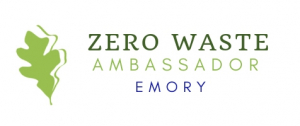
From Trash to Art – Artists are Breathing Life into Garbage to Stimulate Change
By: Erica Kahn, First year in the 4+1 BS/MPH program in Environmental Health, Junior in Emory College majoring in Environmental Science and minoring in English
One of the best parts about making or viewing art is the positive feedback loop it creates–that art inspires more art. Almost always, I find that a craft or piece I’m working on inspires a “by-product” piece. Whether it’s the paper used as a palette for testing the hues of oranges, reds, and pinks I’ve blended, creating postcards from scraps of paper, embroidering an old t-shirt, finding ways to reuse dried paint brushes, or repurposing agendas into art, the excitement of giving a purpose to garbage sends an adrenaline rush through my body that I wouldn’t otherwise feel. One way environmental activists are restoring life in trash is through art, bringing awareness to the waste and pollution we create every day. Below, I’ve shared five artists that have turned waste into beautiful, inspiring, and eye-opening sculptures.
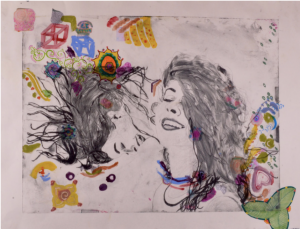
Ella Daish: For months, Ella Daish spent her time collecting and disinfecting over 1,000 tampon applicators that were found in her local environment, on the beach, or waterways to create a 6 ft. tampon. One of the most interesting parts about her project to me was that 87.5% of the tampon applicators found were Tampax, showing that if businesses were held accountable and removed plastic from the source, our environment would be less polluted, especially since applicators are only used for a few seconds before being tossed. Her artwork also brings to light the lack of eco-friendly alternatives available to women during their periods.
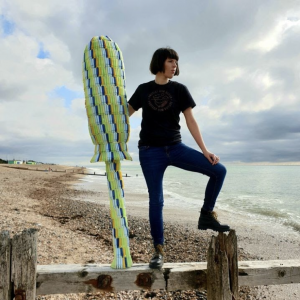
Cod Steaks: Sue Lipscomb: Cod Steaks is a design and build company that creates engaging and memorable experiences through their work. “The Bristol Whales” represents the ocean’s fragility and increasing human threat to ecosystems globally. The project used locally harvested willow to create two life-sized whales swimming through a sea of plastic. About 70,000 plastic bottles were recycled from the Bath half marathon and Bristol 10k. The link to
This article shows a video of the process and more images of the life-size sculpture.
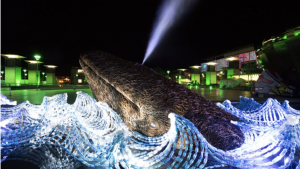
Washed Ashore: Angela Haseltine Pozzi (two links) Washed Ashore is a nonprofit that collects garbage from the Oregon coast and transforms it into the local animals that are put in danger due to the trash. The first link is the link to the non profit itself and the second is a link to a New York Times article describing the work they do. Washed Ashore has displayed their art at the UN plaza in New York, Oregon Zoo, Seaworld, Disney world, and the Smithsonian to name a few. They’ve collected 26 tons of garbage and have turned that into 70 large sculptures; however, this does not dent the pollution issue we are facing today. While many of these projects cannot solve the solution, they turn the ominous pollution problem into a tangible masterpiece that ultimately educates and inspires others. The picture below shows Pozzi standing next to a 6 ft. tall tufted puffin.
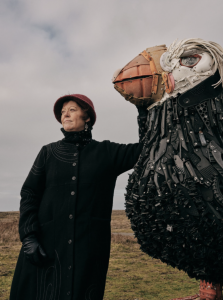
Polluted Water Popsicles: students at the National Taiwan University of Arts: The Polluted Water Popsicles project was brought to life by three students at the National Taiwan University of Arts to bring awareness to water pollution. Their art consists of collecting polluted water from over 100 sources, freezing them into yummy popsicles, then making them durable by adding transparent polyester resin. Using visibly polluted water in the form of popsicles is an original and creative way to highlight the issue of water pollution that provokes an unsettling and awesome feeling.
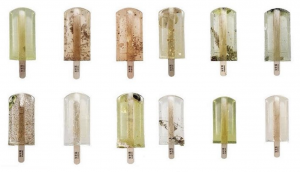
Tom Kiefer : Last but not least is Tom Kiefer, a janitor at a U.S. Customs and Border Protection facility near Ajo, Arizona. His artwork differs from the other artists in that his message is not directly related to the environment or animals. Instead, he secretly collected seized items from immigrants that were deemed potentially lethal or nonessential by border officials and photographed them. His photographs look like pop art with fun bright colors but the content is somber as it highlights the racism and cruelty experienced and exacerbated at the border. Some examples of “potentially lethal items” photographed by Kiefer include CDs, toothpaste, a diary, baby shoes, water bottles, and Bibles. Kiefer says that this project, “El Sueno Americano” (The American Dream) is an ongoing project he hopes to do for a long time and ultimately hopes it will lead to action and change. He plans to donate the objects to a university so they can live on as historical documents of how the government treats immigrants.
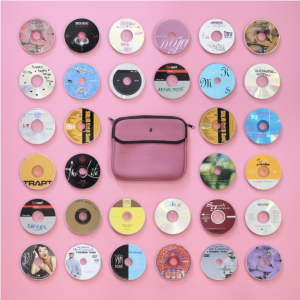
These artists have inspired me to look at everyday items with a new found value and through a creative lens, and I hope you will also look at garbage and think of ways to bring them back to life. I think my next quarantine project will be to make something out of used masks!
